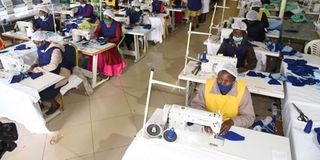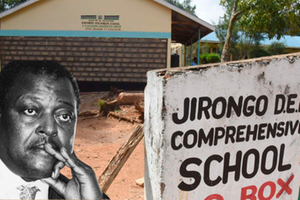Premium
Rivatex races against time to produce face masks for schools

Workers making face masks at the Rivatex factory in Eldoret.
Rivatex East Africa Limited is faced with challenges as it sets out to produce 1.7 million face masks daily to attain a State target of 26 million masks for learners as it races to beat the January 4 schools re-opening date.
The textiles firm has stepped up operations, producing an average of 80,000 daily, against a target of 1.7 million.
“We are currently operating 24 hours to be able to make 6.7 million face masks for schools,” said Prof Thomas Kipkurgat, the company’s managing director.
The government has identified three firms, among them Rivatex, Kitui County Textiles Centre (Kicotec) and the National Youth Service (NYS), for mass production of face masks for learners.
According to Education Cabinet Secretary George Magoha, the government will make 26 million face masks available to pupils ahead of re-opening of schools.
“We will prioritise the most vulnerable children. The Ministry will ensure every school has running water and hand sanitisers,” said Prof Magoha when he toured the facility recently.
Partnership
In a bid to hit the target, Rivatex has partnered with several small and medium enterprises (SMEs) to boost its capacity to supply the face masks.
“Kenya Commercial Bank (KCB) and United Nations Children's Fund (Unicef) have sponsored the production of face masks,” Prof Kipkurgat said.
The Eldoret-based manufacturer is still faced with bottlenecks despite the government and development partners pumping billions into its revival.
Inadequate raw material, high labour and electricity costs are some of the factors which have led to slow recovery of the once vibrant textile firm.
The company’s management has in the past admitted that it was operating below capacity due to serious shortage of cotton, producing an average of 40,000 bales against a capacity of 70,000 bales annually.
Cotton supply
It requires more than 500,000 acres of cotton to ensure steady supply of its mills for smooth operations.
“We do not have certified Bt cotton seeds in the market which means we are recycling the conventional seeds, translating to low productivity,” the MD said in a past interview, adding that the company has partnerships with counties in the region to boost supply.
The North Rift region produced 852.60 tonnes of cotton from 794.5 hectares last season.
Kenya produces an average of 5,300 tonnes of cotton against a demand of about 38,000 tonnes with the deficit, worth about Sh17 billion, being imported from neighbouring countries.
Bt cotton, which is resistant to ball worm pests, is being trialled in traditional cotton-growing regions and diversification into the variety will boost availability of fabrics for textile manufacturing firms.
The trial for cultivation of Bt cotton is ongoing in six counties: Busia, Baringo, Tana River, Kirinyaga, Makueni and Meru.
Financial rescue
The government recently injected Sh650 million into modernisation of New Rivatex, partly from financial support from development partners.
“The release of the funds will fast-track modernisation of Rivatex, expand job creation and markets for cotton,” Dr Francis Owino, Industrialisation Principal Secretary (PS), said when he toured the firm early this year.
New Rivatex secured a Sh3 billion loan last year from the Indian government and an additional Sh3 billion from the Treasury to replace obsolete machines. In the 2019-2020 budget, the firm was allocated Sh1.1 billion.
The textile firm was bought by Moi University at Sh205 million after it was placed under receivership more than 10 years ago.






